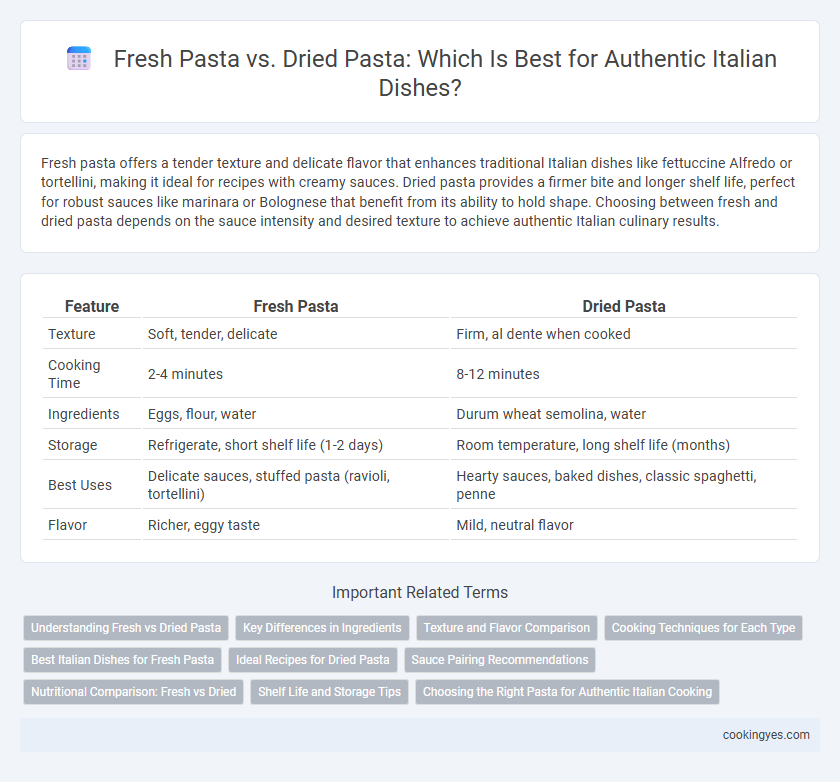Fresh pasta offers a tender texture and delicate flavor that enhances traditional Italian dishes like fettuccine Alfredo or tortellini, making it ideal for recipes with creamy sauces. Dried pasta provides a firmer bite and longer shelf life, perfect for robust sauces like marinara or Bolognese that benefit from its ability to hold shape. Choosing between fresh and dried pasta depends on the sauce intensity and desired texture to achieve authentic Italian culinary results.
Table of Comparison
| Feature | Fresh Pasta | Dried Pasta |
|---|---|---|
| Texture | Soft, tender, delicate | Firm, al dente when cooked |
| Cooking Time | 2-4 minutes | 8-12 minutes |
| Ingredients | Eggs, flour, water | Durum wheat semolina, water |
| Storage | Refrigerate, short shelf life (1-2 days) | Room temperature, long shelf life (months) |
| Best Uses | Delicate sauces, stuffed pasta (ravioli, tortellini) | Hearty sauces, baked dishes, classic spaghetti, penne |
| Flavor | Richer, eggy taste | Mild, neutral flavor |
Understanding Fresh vs Dried Pasta
Fresh pasta, made from eggs and flour, offers a delicate texture and cooks quickly, making it ideal for rich sauces and traditional Italian dishes like ravioli and fettuccine Alfredo. Dried pasta, composed of durum wheat semolina and water, has a firm texture and longer shelf life, perfect for hearty recipes such as spaghetti Bolognese or baked ziti. Understanding the differences in ingredients, cooking times, and texture helps select the best pasta type to enhance the authenticity and flavor of Italian cuisine.
Key Differences in Ingredients
Fresh pasta contains higher moisture content and is made primarily from eggs and soft wheat flour, resulting in a tender texture ideal for delicate sauces. Dried pasta uses hard durum wheat semolina and water, providing a firmer bite and longer shelf life, perfect for robust, hearty Italian dishes. The choice between fresh and dried pasta significantly affects cooking time, texture, and flavor absorption in traditional Italian recipes.
Texture and Flavor Comparison
Fresh pasta offers a tender texture and richer flavor due to its high moisture content and use of eggs, making it ideal for delicate sauces in Italian dishes. Dried pasta provides a firmer bite and more concentrated wheat taste, which holds up well in robust sauces and long cooking times. Choosing between fresh and dried pasta depends on the desired texture and flavor profile of the specific Italian recipe.
Cooking Techniques for Each Type
Fresh pasta requires a shorter cooking time of 2-3 minutes in boiling salted water to maintain its delicate texture and freshness, often benefiting from gentle handling to avoid tearing. Dried pasta, typically made from durum wheat semolina, needs longer boiling times of 8-12 minutes for al dente firmness and holds up better in robust, sauce-heavy Italian dishes. Properly matching cooking times and stirring techniques ensures optimal texture and flavor absorption for both fresh and dried pasta varieties.
Best Italian Dishes for Fresh Pasta
Fresh pasta's tender, delicate texture is ideal for rich sauces like creamy Alfredo or delicate seafood-based ragu, allowing the flavors to meld seamlessly. Dishes such as Tagliatelle al Ragu Bolognese and Pappardelle with Porcini mushrooms highlight fresh pasta's ability to absorb and complement hearty, slow-cooked sauces. Unlike dried pasta, fresh pasta cooks quickly and pairs best with vibrant, fresh ingredients, enhancing traditional Italian recipes with authentic taste and texture.
Ideal Recipes for Dried Pasta
Dried pasta is ideal for hearty Italian dishes such as spaghetti Bolognese, penne arrabbiata, and baked ziti because its firm texture holds up well to robust sauces and prolonged cooking times. Recipes that include chunky tomato-based sauces or baked preparations benefit from dried pasta's ability to maintain structure without becoming mushy. Classic Italian recipes like lasagna and pasta al forno commonly utilize dried pasta to achieve perfect layering and absorb flavors effectively.
Sauce Pairing Recommendations
Fresh pasta, with its tender texture and delicate flavor, pairs exceptionally well with light sauces such as beurre blanc, seafood-based sauces, or simple tomato and basil. Dried pasta, being firmer and denser, complements robust and hearty sauces like Bolognese, arrabbiata, or rich cream sauces, as it holds up better during long cooking and saucing. Choosing the right pasta type enhances the overall balance and authenticity of Italian dishes by optimizing sauce absorption and texture contrast.
Nutritional Comparison: Fresh vs Dried
Fresh pasta typically contains higher moisture content and fewer preservatives, resulting in a softer texture and slightly lower calorie density compared to dried pasta. Dried pasta, with its longer shelf life, often boasts a higher protein concentration and complex carbohydrate content due to its dehydration process. Both types provide essential nutrients such as B vitamins and iron, but fresh pasta generally offers more vitamins from eggs and fresh ingredients, while dried pasta delivers greater fiber levels, especially when made from whole wheat.
Shelf Life and Storage Tips
Fresh pasta typically lasts 2 to 3 days in the refrigerator and should be kept in an airtight container to maintain moisture and prevent spoilage. Dried pasta has a much longer shelf life, often up to two years when stored in a cool, dry place away from direct sunlight. Proper storage conditions for both types ensure optimal texture and flavor, with fresh pasta requiring refrigeration and dried pasta benefiting from airtight packaging to avoid humidity.
Choosing the Right Pasta for Authentic Italian Cooking
Fresh pasta, made from eggs and flour, offers a delicate texture and cooks quickly, ideal for rich sauces like carbonara or ragu. Dried pasta, typically made from semolina and water, provides a firmer bite and longer shelf life, perfect for hearty, slow-cooked dishes such as Bolognese or pasta al forno. Selecting the right pasta type enhances authenticity, balancing texture and flavor to complement traditional Italian recipes.
Fresh pasta vs dried pasta for Italian dishes Infographic

 cookingyes.com
cookingyes.com